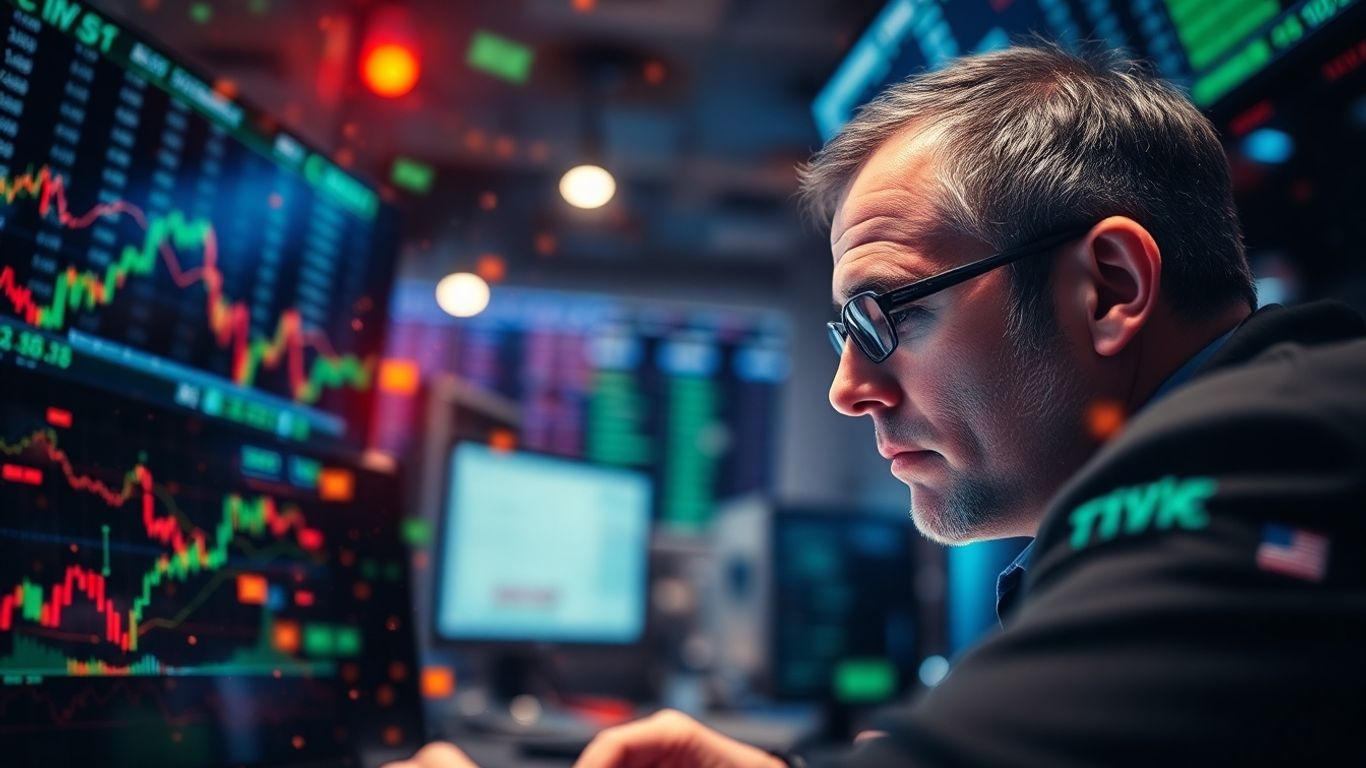Getting into automated trading strategies might seem complicated, but it's really about using computers to make trades for you. Think of it like setting up a system that watches the market and acts when certain conditions are met. This guide breaks down how to go from just hearing about automated trading strategies to actually using them, covering the basics, picking the right tools, and even some more advanced stuff. We'll keep it simple so you can start building your own automated trading strategies with confidence.
Key Takeaways
- Start by getting a handle on the basics like backtesting, which is testing your strategy on old data, and understanding what you want to achieve with your trading goals. Picking the right time frame and market is also a big first step for any automated trading strategies.
- You'll need the right software for your automated trading strategies. Look for tools that fit how you want to trade, are reliable, and have good support. Make sure the software can actually do what your strategy needs it to do.
- Once you've picked your software, learn its advanced features. This includes using its backtesting and optimization tools, understanding charting, and setting up risk management. Knowing these details helps make your automated trading strategies work better.
- Putting your automated trading strategies into action means building and testing your algorithms. Then, set up alerts so you know what's happening in the market and watch how your strategy is performing. Use this information to make smart changes.
- The world of automated trading strategies is always changing. Keep learning about new market trends and technology. Trying out new algorithms and tools can help you stay sharp and improve your automated trading strategies over time.
Understanding The Fundamentals Of Automated Trading Strategies
Getting into automated trading can feel like learning a new language, but it's really about setting up rules for your computer to follow. Think of it as giving very specific instructions to a super-fast assistant who never gets tired or emotional. This assistant's job is to watch the markets and make trades based on what you've told it to look for. It's not magic; it's just a different way of trading that relies on logic and speed. We'll break down the core ideas so you can start building your own automated systems.
Grasping Core Concepts: Backtesting, Optimization, and Execution
Before you even think about letting a program trade for you, there are a few key ideas you need to get comfortable with. First up is backtesting. This is like a historical movie of your trading idea. You take your strategy and run it on past market data to see how it would have performed. Did it make money? How much did it lose during bad times? This helps you understand if your idea has potential before risking real cash.
Then there's optimization. Once you've backtested, you might find your strategy isn't quite hitting the mark. Optimization is the process of tweaking the settings of your strategy – things like how sensitive it is to price changes or how long it waits for a signal – to try and improve its performance on that historical data. It's a bit like tuning a radio to get the clearest signal.
Finally, we have execution. This is the actual act of placing the trade in the market. How does your system tell the broker to buy or sell? Are you using simple market orders that just get filled at whatever the current price is, or limit orders that only fill at a price you specify? The way trades are executed can make a big difference to your results, especially in fast-moving markets. Getting these three concepts right is the bedrock of any successful automated trading setup.
Defining Your Trading Goals and Objectives
So, why are you doing this? It sounds like a simple question, but it's really important. Are you trying to make a little extra cash on the side, or are you aiming to build a full-time income stream? Maybe you're focused on preserving your capital above all else, or perhaps you're willing to take on more risk for potentially higher returns. Your goals will shape everything else you do. For instance, someone aiming for slow, steady growth might use different strategies and time frames than someone looking to capture quick profits from short-term price swings.
Here are some common objectives traders set:
- Capital Preservation: Keeping your initial investment safe is the top priority.
- Income Generation: Aiming for regular profits to supplement other income.
- Aggressive Growth: Seeking high returns, even if it means taking on more risk.
- Market Neutrality: Trying to profit regardless of whether the market goes up or down.
Understanding your personal financial situation and what you want to achieve with trading is the first step. Don't just jump in because you heard about someone making a lot of money. Have a clear plan for yourself.
Selecting The Right Time Frame And Market
This is where you decide when and where your automated system will be active. The time frame refers to the period your charts represent – are you looking at minute-by-minute price action, hourly trends, or daily patterns? Different strategies work better on different time frames. For example, strategies that rely on small price movements might do well on very short time frames, while trend-following strategies often need longer periods to develop.
Choosing the right market is just as important. Are you trading stocks, forex, cryptocurrencies, or commodities? Each market has its own quirks, volatility levels, and trading hours. Some markets are more liquid than others, meaning it's easier to buy and sell without significantly impacting the price. Your automated strategy needs to be suited to the specific characteristics of the market you choose. For instance, a strategy that works well in the relatively stable stock market might fail miserably in the highly volatile crypto space. It's about finding the right fit for your automated trading system.
Choosing The Right Tools For Automated Trading Strategies

Alright, so you've got a trading idea, maybe even a rough algorithm sketched out. That's awesome! But before you can even think about letting a computer run wild with your money, you need the right gear. Picking the right software isn't just about picking the prettiest interface; it's about finding a partner that can actually do what you need it to do, reliably.
Evaluating Software Features And Compatibility
Think of software like a toolbox. You wouldn't bring a hammer to a screw-driving job, right? You need tools that fit your specific strategy. Some platforms are built for super-fast, high-frequency trading, while others are more geared towards longer-term trend following. You'll want to check if the software supports the markets you want to trade in – stocks, forex, crypto, whatever. Also, consider how easy it is to actually build your strategy. Does it have a visual builder, or do you need to be a coding wizard? Compatibility with your existing setup is also a big deal. You don't want to buy a system that clashes with your broker or your operating system.
Assessing Reliability, Speed, And Customer Support
This is where things get serious. If your trading software glitches out at the wrong moment, you could lose a lot of money. So, reliability is king. Look for reviews or ask around about how stable the platform is. Speed matters too, especially if you're dealing with fast-moving markets. A few milliseconds can make a difference. And what happens when something goes wrong? Good customer support can be a lifesaver. Are they responsive? Do they actually help you solve problems, or do you just get bounced around? A quick look at their support channels and response times can tell you a lot.
Aligning Software With Your Specific Trading Strategies
This ties back to the first point, but it's worth hammering home. Let's say you're into mean reversion strategies. You'll need software that can easily calculate statistical measures and identify price deviations. If you're a trend follower, you'll want robust charting tools and indicators like moving averages readily available. Some platforms are better at handling complex order types, which might be important for your strategy. It's not a one-size-fits-all situation. You need to match the software's capabilities to the exact logic of your trading plan. Here's a quick rundown of things to consider:
- Strategy Type: Does the software support your chosen approach (e.g., trend following, arbitrage)?
- Indicators: Are the technical indicators you rely on built-in or easily added?
- Backtesting: How robust are its historical testing capabilities?
- Execution: Does it offer the order types and speed you need?
- Broker Integration: Does it connect smoothly with your preferred broker?
Don't get swayed by flashy features you'll never use. Focus on what your strategy actually requires. A simpler tool that does exactly what you need is far better than a complex one that overwhelms you or fails to perform its core functions.
Mastering Advanced Features For Automated Trading Strategies
So, you've got the basics down and maybe even picked out some software. Now it's time to really dig into what makes automated trading tick. This isn't just about setting up a simple buy or sell order; it's about fine-tuning your system to perform optimally. We're talking about the nitty-gritty that can separate a decent trading bot from a truly effective one.
Leveraging Backtesting and Optimization Tools
Backtesting is your time machine. It lets you see how your strategy would have performed using historical data. Think of it like test-driving a car on a closed track before you take it out on the highway. You want to see how it handles different conditions, right? For backtesting, you'll want to look at metrics like the Sharpe Ratio to understand risk-adjusted returns, and keep a close eye on maximum drawdown – that's the biggest dip your account took. A strategy that looks good on paper but craters your account in a drawdown isn't much use.
Optimization tools are the next step. Once you've backtested, you'll likely find areas where your strategy could be better. Optimization lets you tweak parameters – like the length of a moving average or the threshold for an RSI indicator – to find the sweet spot. It's a bit like tuning an engine. You're not changing the engine itself, just adjusting the settings to get the best performance. Be careful though; it's easy to over-optimize, making a strategy that only works on past data and fails in live trading. This is sometimes called 'curve fitting'.
Understanding Technical Indicators and Charting Capabilities
Technical indicators are the language of charts. Things like Moving Averages, MACD, RSI, and Bollinger Bands give you clues about market sentiment and potential price movements. Understanding what each indicator tells you, and how they can work together, is key. For example, a moving average crossover might signal a trend change, while RSI can tell you if a market is overbought or oversold. Most trading platforms offer a wide array of these, and knowing which ones fit your strategy is important. Some platforms even let you build custom indicators, which can be a game-changer if you have a unique idea.
Charting capabilities go hand-in-hand with indicators. Can your software draw clean charts? Does it allow you to easily add and remove indicators? Can you set up different chart types, like candlestick or bar charts? The visual aspect is important for quickly assessing market conditions. Being able to spot patterns or trends on a chart can inform your automated strategy's decisions. For instance, if your strategy is designed to catch breakouts, you need clear charting to identify those breakout points.
Exploring Risk Management Settings
This is arguably the most important part. No strategy is foolproof, and markets can be unpredictable. Good risk management is what keeps you in the game. This means setting stop-loss orders to automatically exit a trade if it goes against you by a certain amount. It also involves position sizing – deciding how much capital to allocate to any single trade. A common rule of thumb is to risk only 1-2% of your total trading capital on any one trade. This prevents a few bad trades from wiping out your account.
Here are some key risk management settings to look for:
- Stop-Loss Orders: Automatically close a losing trade at a predetermined price.
- Take-Profit Orders: Automatically close a winning trade at a target price.
- Position Sizing Rules: Calculate trade size based on account balance and risk tolerance.
- Maximum Drawdown Limits: Set a threshold for overall account loss before halting trading.
Effective risk management isn't about avoiding losses entirely; it's about controlling them so you can survive to trade another day. It's the safety net that allows your strategy to function without catastrophic failure.
When you're looking at software, make sure it has robust options for these settings. Platforms like Lune Trading offer AI-powered tools that can help manage risk, removing some of the emotional decision-making that can lead to costly mistakes. Being able to configure these settings precisely within your automated system is what allows you to trade with confidence, knowing that your downside is protected.
Implementing And Monitoring Automated Trading Strategies
So, you've got your trading idea, you've picked your software, and maybe even tinkered with some advanced settings. Now comes the real work: putting it all into action and keeping a close eye on how it performs. This isn't just about hitting 'go' and walking away; it's about a structured approach to launching your automated system and making sure it's actually doing what you designed it to do.
Developing and Backtesting Trading Algorithms
This is where your strategy goes from a concept to a testable plan. You'll need to translate your trading rules into code or a visual scripting language, depending on your platform. Think of it like writing a recipe – every ingredient and step needs to be precise. Once you have your algorithm, the next step is backtesting. This means running your algorithm on historical market data to see how it would have performed in the past. It's not a crystal ball, but it gives you a solid idea of potential profitability and risks. You'll want to look at things like:
- Maximum Drawdown: How much could you have lost from a peak to a trough?
- Win Rate: What percentage of trades were profitable?
- Profit Factor: The ratio of gross profits to gross losses.
Don't just test on one period; try different market conditions. If your algorithm only works well in a bull market, it might be a problem. You're aiming for robustness, not just a lucky streak on old data.
Setting Up Alerts and Notifications for Market Movements
Even with automation, you can't just forget about it. Markets are unpredictable, and sometimes your algorithm needs a nudge, or you need to know when something significant happens. Setting up alerts is key here. These can be triggered by various events:
- Significant Price Movements: Get notified if a specific asset moves by a certain percentage or amount.
- Indicator Thresholds: Be alerted when a technical indicator crosses a level you've defined.
- Trade Execution: Receive confirmation when your algorithm opens or closes a trade.
- System Errors: Crucially, get notified if your trading software encounters an issue.
These alerts act as your eyes and ears, allowing you to intervene if necessary or simply stay informed about your system's activity without needing to stare at charts all day. It's about efficient monitoring, not constant babysitting. You can find more information on managing your trading activities with minimal oversight in this article on automated trading.
Reviewing Performance Metrics for Data-Driven Decisions
After your algorithm has been running live for a while, it's time to see how it's really doing. Backtesting is one thing, but live trading is another. You need to regularly review performance metrics. This isn't just about looking at your account balance; it's about digging into the details:
- Compare Live vs. Backtest: How does the actual performance stack up against your historical simulations?
- Analyze Trade Logs: Look at individual trades. Are there patterns in losing trades? Are winning trades performing as expected?
- Risk-Adjusted Returns: Metrics like the Sharpe Ratio can tell you if the returns you're getting are worth the risk you're taking.
This ongoing review process is vital. Markets change, and what worked yesterday might not work tomorrow. By consistently analyzing your performance data, you can identify areas for improvement, tweak your algorithms, or even decide to switch strategies if one isn't performing as expected. It’s a cycle of implementation, monitoring, and refinement.
This data-driven approach helps you adapt and improve, making your automated trading journey more successful over time.
Common Automated Trading Strategies And Techniques

Alright, let's talk about some of the actual ways people automate their trading. It's not all just complex code; there are distinct approaches people use to try and make money in the markets automatically. Think of these as different recipes for trading.
Trend-Following and Momentum Strategies
These are probably the most straightforward to grasp. The idea is simple: if something is going up, you buy it, hoping it keeps going up. If it's going down, you sell it (or short it), expecting it to keep falling. It's all about riding the wave. You'll often see this done using things like moving average crossovers. For example, when a short-term moving average crosses above a long-term one, that's a signal to buy. When it crosses back below, it's time to sell. Momentum strategies are similar, looking at how fast prices are changing. The core principle is to follow the herd, assuming trends will continue.
Mean Reversion and Arbitrage Algorithms
These are a bit more sophisticated. Mean reversion bets on prices eventually returning to their average. So, if a stock suddenly spikes way up, a mean reversion strategy might bet on it coming back down. It's like a rubber band – stretch it too far, and it snaps back. Arbitrage, on the other hand, is about finding tiny price differences for the same asset in different markets. You buy low in one place and immediately sell high in another. This usually requires super-fast computers and is often the domain of big firms, but the concept is about exploiting market inefficiencies. You can find more details on these types of automated trading strategies here.
Market-Making and Pairs Trading
Market makers are the folks who are always willing to buy or sell. They put in both buy and sell orders, and they make their money on the difference between the highest price someone is willing to pay (the bid) and the lowest price someone is willing to sell (the ask). They provide liquidity, which is good for everyone. Pairs trading is another interesting one. You find two assets that usually move together, like two oil companies' stocks. If one suddenly moves out of sync with the other, you bet they'll realign. You might buy the underperformer and sell the outperformer, hoping their prices converge again.
Here's a quick look at how some of these might play out:
- Trend Following: Buy when price is rising, sell when falling.
- Mean Reversion: Buy when price drops significantly below average, sell when it rises significantly above.
- Arbitrage: Buy asset A in Market X, sell asset A in Market Y simultaneously.
- Market Making: Place both buy and sell orders, profit from the bid-ask spread.
Remember, no strategy is foolproof. The market is always changing, and what works today might not work tomorrow. It's about finding what fits your style and risk tolerance, and then testing it thoroughly.
Continuous Learning And Adaptation In Automated Trading
The world of automated trading moves fast. What worked yesterday might not be the best approach today. That's why staying sharp and keeping up with changes is super important. It’s not just about setting up a system and forgetting about it; you’ve got to be in it for the long haul, always learning.
Staying Updated On Market Trends And Technological Advancements
Markets shift, and new tech pops up all the time. Keeping an eye on these changes helps you spot new chances or avoid potential problems. Think about how AI trading bots are changing things – they learn and adjust on the fly. You need to do something similar, even if it’s just reading up on what’s new. It’s about being aware of the bigger picture and how new tools or market behaviors could affect your strategies.
Attending Workshops And Networking With Experts
Sometimes, reading isn't enough. Going to workshops or online seminars can give you practical insights. You get to hear directly from people who are actually doing this stuff. Plus, talking to other traders, even just online, can be really helpful. You might pick up a tip or two, or find out about a new tool someone is using. It’s good to connect with others in the field.
Experimenting With New Algorithms And Cutting-Edge Tools
Don't be afraid to try new things. Maybe you read about a new type of algorithm, or a software update adds a cool feature. Test it out! Start small, maybe with a paper trading account or a tiny amount of real money. See how it performs before you commit more. This kind of experimentation is how you find what really works and how you can improve your trading. It’s a bit like trying a new recipe – you tweak it until it’s just right.
The key is to not get stuck in your ways. The markets are always changing, and so should your approach. Being willing to adapt and learn is what separates traders who just get by from those who really succeed over time.
Wrapping It Up
So, we've covered a lot of ground, from the basic ideas behind automated trading to actually getting strategies up and running. It's not exactly a walk in the park, and there's definitely a learning curve involved. But by sticking with it, understanding the tools, and always looking for ways to improve your approach, you can really make this work for you. The financial world moves fast, and having a solid automated system can give you a real edge. Keep learning, keep experimenting, and you'll be well on your way to becoming a more effective trader.
Frequently Asked Questions
What exactly is automated trading?
Automated trading means using computer programs, called algorithms, to make trades for you. These programs follow specific rules you set up. They can buy or sell things like stocks super fast, often much quicker than a person could. It's like having a robot trader working for you.
Do I need to be a computer expert to start?
Not necessarily! While knowing how to code can be helpful, many tools and platforms make it easier for beginners. You can start by learning the basic ideas and using software that has user-friendly options. Think of it like learning to drive – you don't need to be a mechanic to get started.
What is 'backtesting' and why is it important?
Backtesting is like a practice run for your trading idea. You use old market information to see how your algorithm would have performed in the past. This helps you find out if your strategy is likely to make money or lose it before you risk real cash.
How do I know which trading software is best for me?
Choosing the right software depends on what you want to do. Look for programs that are easy to use, work with your trading style, and offer the features you need, like good backtesting tools. It's also smart to check if the company offers good help if you get stuck.
What are some common types of automated trading strategies?
Some popular strategies include following trends (buying when prices go up and selling when they go down), mean reversion (betting that prices will go back to normal after unusual moves), and arbitrage (making money from tiny price differences in different markets).
Is automated trading risky?
Yes, all trading has risks. Automated trading can help manage risk by sticking to rules, but it's not foolproof. Markets can change quickly, and even the best algorithms can sometimes lose money. It's important to start small, learn a lot, and never trade with money you can't afford to lose.










